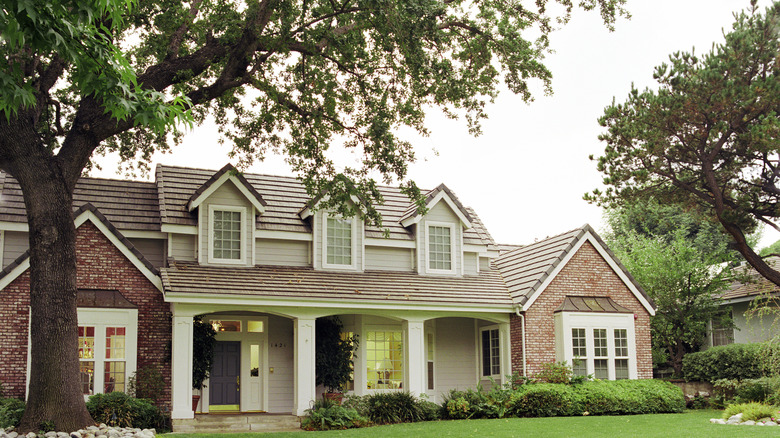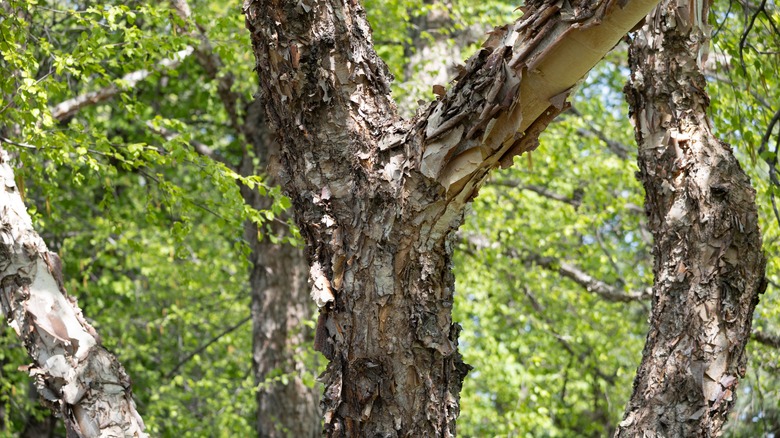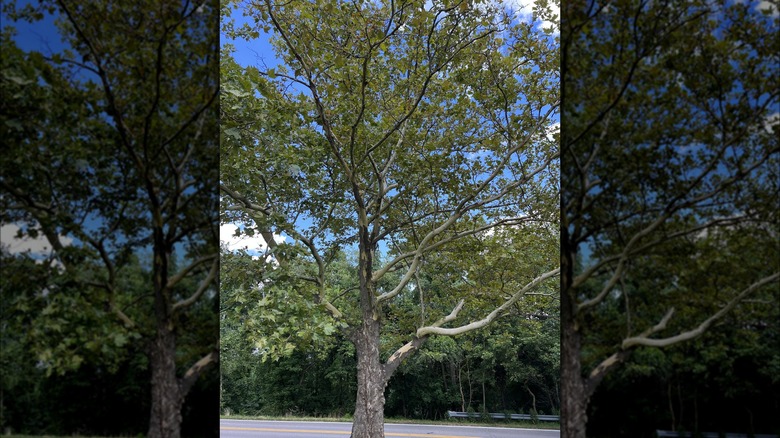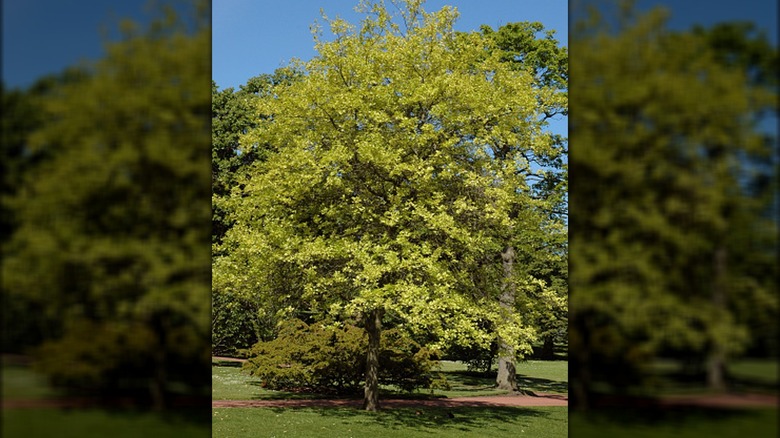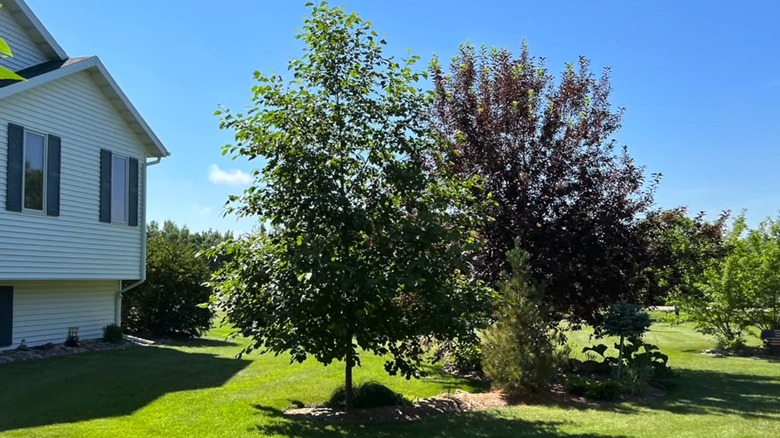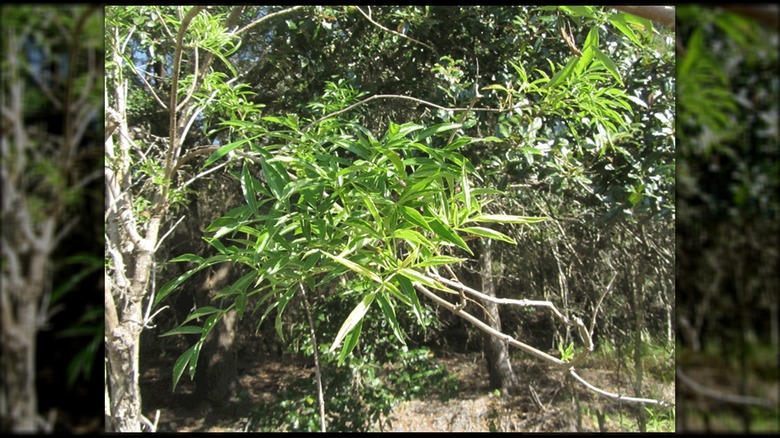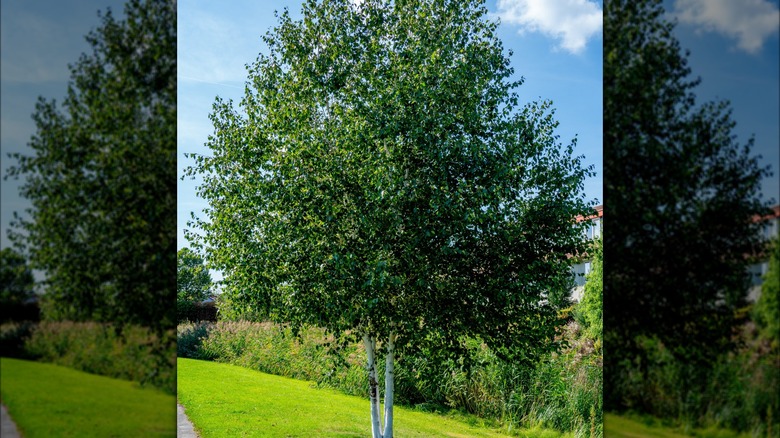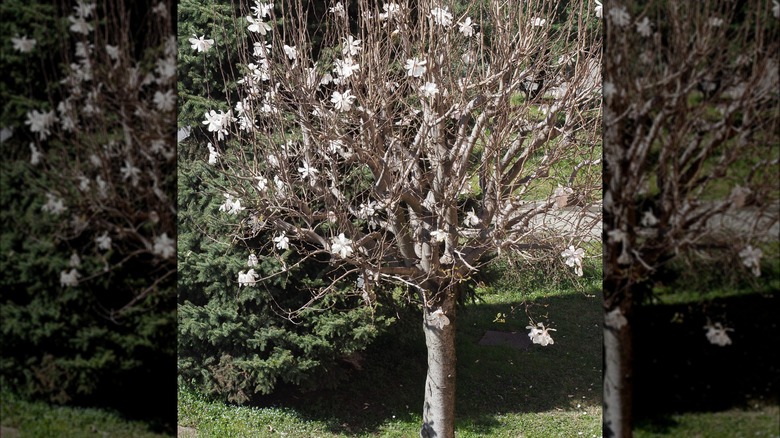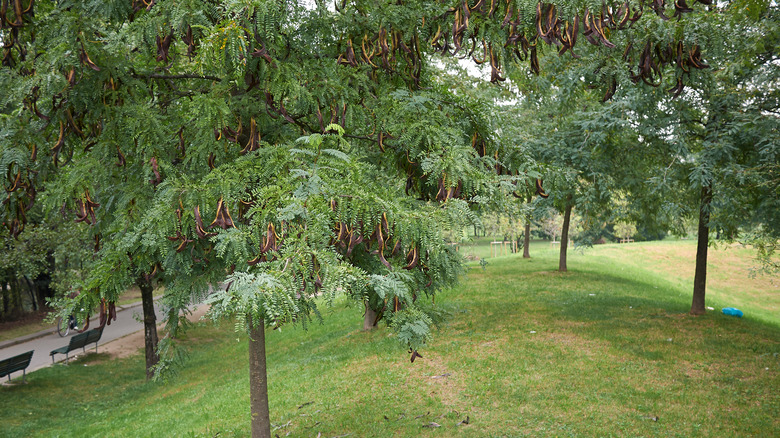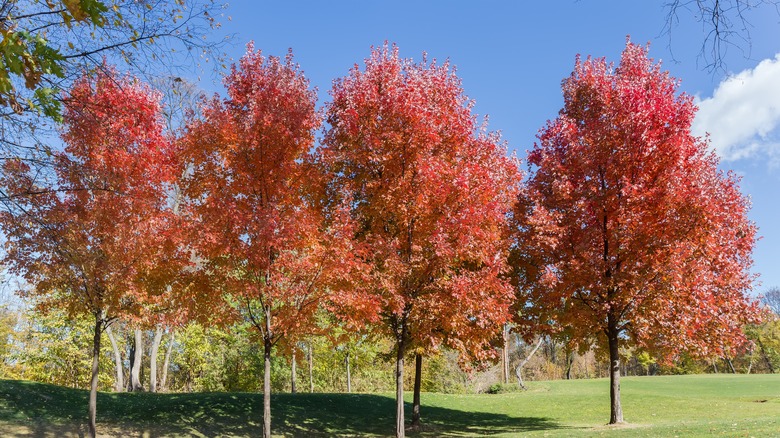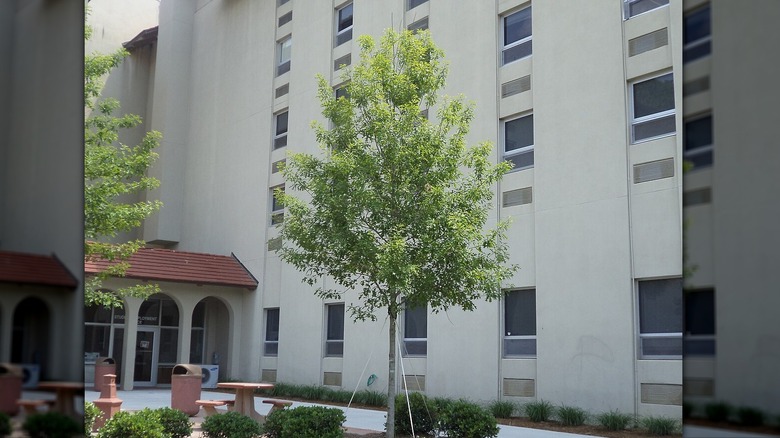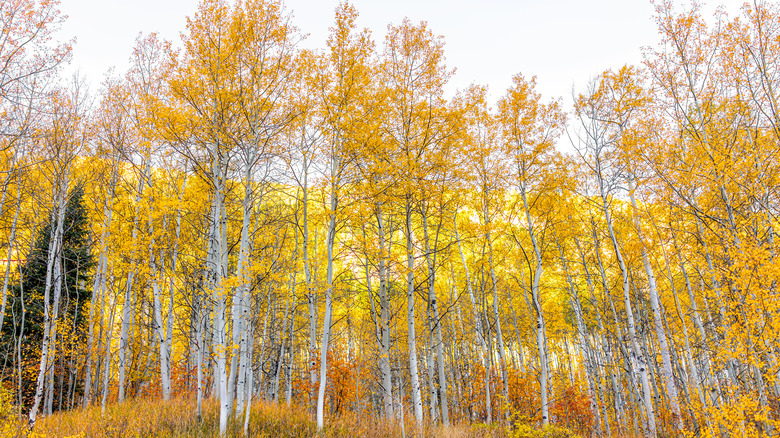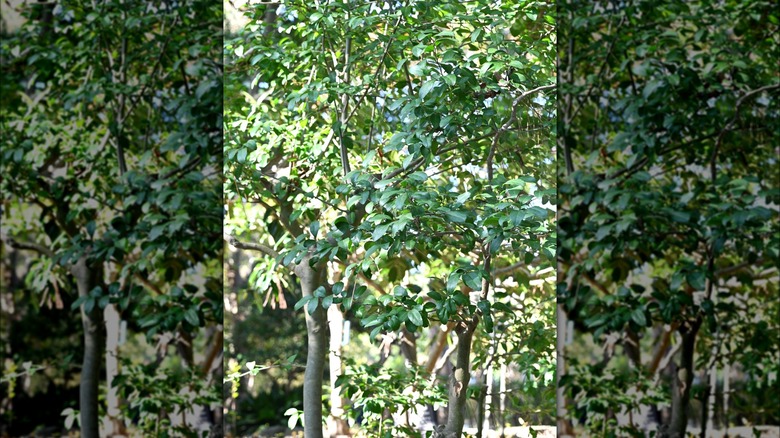Fast-Growing Trees That Will Thrive In Damp Soil
Striking the right air-water balance in the soil is key to growing healthy trees. So, when you plant your sentinels in perpetually damp sites — courtesy of high water tables, clay content, or year-round rainfall — most falter because their roots starve for oxygen. While the lack doesn't kill them, it stresses them out, weakening their defenses against soil-borne pathogens that make no delays in delivering the fatal blow. Although soil amendments are often proposed as remedies, they rarely work for trees unless you work them throughout the soil and not just the top layers, as is the usual scenario for shrubs. Hence, a better option is to borrow a leaf from the book on simple tricks for restoring your muddy lawn and choose plants inherently cut out for boggy areas and tally their growth requirements to your yard's conditions.
As trees sited in wet soils must soak up the surrounding water, they generally keep their root systems shallow to accomplish the task adequately. So, if planted in the wrong spot, they might interfere with traffic or damage structural elements. Being winter hardy in your location is another requirement. Thankfully, there's no dearth of selections, with river birch, American sycamore, pin oak, and more making the list, as discussed below.
River birch trees shade your yard naturally
Featuring a 40-foot-wide canopy of rhomboidal, serrated green leaves that expose their grayish-green undersides when wind-swept, river birch (Betula nigra) is the fast-growing tree that'll provide natural shade for your yard. What makes the native tree an absolute head-turner is its ornamental, four-season bark. Given to constant peeling (and seasonal bleeding), its rustic-pink bark flakes off like paper peels, aging into deeply grooved, dark gray tissues that look charming with their retained traces of salmon-pink. Several nurseries grow them as clumps to create multi-trunked trees with unique, asymmetrical crowns, as opposed to preserving their pyramidal shape. Come spring, these trees blaze in yellow catkins that birds and mammals love to munch. Alas, the tree is also a snacking site for white-tailed deer. Additionally, you may find pine siskins and turkeys scourging for seeds while the tree shelters mourning cloak butterflies' larvae.
Gaining over 1½ feet annually, the borer-resistant tree can reach almost 70 feet at maturity, effectively serving as a living screen, windbreak, or a specimen. But if you want something shorter, Little King, Shiloh Splash, or the weepy Summer Cascade are notable cultivars. Well-adapted in USDA zones 4 through 9, river birch trees thrive in full sun on moist, acidic soils — alkalinity makes their foliage chlorotic. Avoid planting these popular trees too close to home, as their twigs die back and can block the drainage system while getting your yard messy.
American sycamore looks gorgeous in big yards
Crowned the largest native specimen in the eastern US region, the American sycamore (Platanus occidentalis) is a tree you would want for wet places where most other plants lose hope. Their dormant young trees can withstand a two-month-long flooding season, while their saplings can start over on their own if the water fails to drown their crowns. These deciduous trees are highly tolerant of black walnut trees, alkalinity, and compaction. Another laurel in their crown is their decorative burgundy-brown or gray, speckled camouflage bark that sloughs off to reveal creamy-white inner tissues. Surprisingly, rather than red inflorescence, it's their fuzzy, brown, seed-holding, ball-like fruits — earning the stately tree its moniker as buttonball tree — that attract finches, chickadees, and juncos in hoards.
Hardy in zones 4 to 9, American sycamore trees should be sited in full sun to watch them touch 100 feet top and across. Starting with seed, they grow nearly 10 feet in the first year and gain another 2 feet yearly until maturity. That's why they work better in bigger yards, although the shaded turfgrass will suffer. The clean-up can be substantial, as you could expect from such mammoth-sized trees. Poor disease resistance and aggressive spreading are other major downsides.
Pin oak grows best in acidic soils
Tolerant to saturated soils, urban pollution, droughts, and deer grazing has made pin oak (Quercus palustris) all the rage in residential landscapes of zones 4 through 8. Their extraordinary growth habit sweetens the deal further. These native trees grow a tiered structure with the upper limbs ascending vertically towards the sun while the lower branches nod to the ground and the center middles about laterally. However, this may prompt some homeowners to prune the lower boughs to create the necessary ground clearance. Some pin oaks sprout a competing leader, which must be put down if you hold the central leader look dear. Oak trees electrify the landscape when their 5-inch long, glossy, lobed, emerald foliage transforms into thunderous reds or russet browns in the fall.
Growing oak trees is one of the best birdscaping tips to turn your yard and garden into a bird haven. Their burgundy-copper acorns are prized by wood ducks, blue jays, mallards, and woodpeckers, although squirrels will race them for it. They're also pivotal to several moths and butterflies, including Imperial Moth and hairstreak species. When grown in full sun, pin oaks grow over 15 feet in under seven years, maxing out at 70 feet. Never plant them in alkaline soils, lest the foliage will grow fatally chlorotic. Their thin bark raises the probability of mechanical damage and fungal infections.
Manchurian Alder aids erosion control
So strong is the Manchurian alder's (Alnus hirsuta) affinity for water that its lumber toughens instead of decaying — damp sites and the City of Venice are living proof. The fast-growing tree also enters into a symbiotic relationship with nitrogen-fixing microbes, enriching the ground while keeping leaching under control. Not only does its glib tan-gray bark accent the landscape but it's also used in gargling solutions where its antiseptic properties kick in to relieve throat problems. Its 5-inch-wide, basil-green hairy foliage with burnt sienna mottles for undersides is antimicrobial, too, coming in handy to nurse injuries. This deciduous tree is aglow in droopy lavender catkins from spring through fall that make way for woody cones, keeping your yard dramatic all winter long.
Although indigenous to Asia, Manchurian alder has no history of monopolizing areas outside its cultivation in the US. It is cold hardy in USDA zones 3 to 7 and resists bogs and clay. Sow the scarified seeds in part to full sun or start with juvenile trees, but make sure to shield them initially from voles and mice with a tree guard. The almost 60-foot-tall tree may come under attack from beetles and scales but is otherwise resistant to diseases and pollution, especially its 'Prairie Horizon' cultivar.
Coastal plain willow adds wildlife value to shaded yards
Look to coastal plain willow (Salix caroliniana) trees to green up a deeply shaded, damp site. Their scaly stems are shrouded in sword-shaped, white-bottomed, fern-green foliage that bends to the wind without feeling overwhelmed. During spring, these native trees are painted golden by their bee-hosting catkins bloom, augmenting the creation of the highest quality honey. Viceroy butterflies, eastern tiger swallowtails, mourning cloaks, and diverse moths hide their offspring in this deciduous foliage. Water birds, beavers, deer, and muskrats are no strangers to its charms either. Willow trees keep the yard attractive during the cold season with their grooved, reddish-gray bark and burst out gorgeous, white fruit before other spring bloomers are up.
Coastal plain willow trees are moderately resistant to salt sprays, infertile soils, and fire. They can be planted in zones 6 to 10 as long as the temperatures don't dip below -10 degrees Fahrenheit. They are unfussy about sun exposure but prefer soils with a dash of acidity. Typically growing 30 feet tall and just as wide, the rapid-growing tree can become prolific in home gardens, although it does check soil erosion.
Paper birch thrives in cold climates
A lover of damp soils, paper birch (Betula papyrifera) is a gorgeous tree with white bark that creates a striking backyard contrast, especially when teamed with evergreens. Although, you're more likely to see them decked in golden brown bark during the first 10 years or so of their life. Keen on putting on a winter show, these native trees usually shave off slivers of their papery bark to unveil amber skin, while the more mature of the lot flaunt their age through pronounced black speckles on their tissues. Like their cousins, paper or white birch trees bloom tiny, copperish-green flowers that entice ruffled grouse into your yard. When their seed-containing fruits take over, pine siskins and chickadees herd in to assist with dispersal. Their sunny yellow fall color is another standout feature.
Although paper birch trees are hardy in zones 2 to 7, they prefer staying at higher elevations. That's because warmer climates magnify their susceptibility to deadly bronze birch borers, the pest problem you must worry about when growing white birch trees. Moreover, the intense southern afternoon heat has them bolting for shade despite their partiality to full sun up north. Keep the roots well-watered and snow-covered to experience their imposing 70-foot glory; they'll be shorter if trained into a multi-trunked form. Twig and leaf litter aren't major issues, but you'll have to keep your eyes peeled for signs of canker, aphids, and leafminers.
Sweetbay magnolia lure hummingbirds into your yard
Endemic in the southeastern US region, sweetbay magnolia (Magnolia virginiana) is a beautiful flowering tree that loves damp soil and won't take over your yard. Its glossy, verdant foliage (with silvery backsides) is adorned by day-length sensitive, milky white blooms that impart a pleasant lemony fragrance and garish chirpings of songbirds. Hummingbirds dart in, too, to munch on the vivid red seeds hanging for their dear life from a mere thread radiating from the fall fruits. They're also critical to swallowtail larvae while furnishing small mammals with cover and food during extreme winters. Sweetbay magnolia or beaver trees maintain a narrow columnar canopy throughout their life and are great specimens in limited spaces, near walls, and lawns. However, some cultivars may assume a multi-trunked shape.
Sweetbay magnolias showcase distinct characteristics in their adaptive zones of 5 to 10. Down south, they rely on part to full sun and mildly acidic, moist soils to grow over 60 feet tall while maintaining their evergreen foliage. However, in zones 8 and under, they grow shorter, topping out at 50 feet, shedding their leaves after frost — Henry Hicks and Jim Wilson cultivars are an exception. Regardless, their high resistance to floods, urban pollution, salt, and drought makes them a good candidate. But if you want larger blooms that could compare to southern magnolia trees, grow the Havener variety. Scales and weevils may cause problems occasionally.
Thornless honey locust provides dappled shade
If you want an ornamental shade tree on your lawn without killing the turf underneath, the thornless honey locust (Gleditsia triacanthos var. inermis) species might fit the bill. That's because their graceful, toothed canopies atop snaking arms allow some dappled shade while turning a dazzling yellow come fall — cleanup is minor, too. Bred to lose their thorns (technically modified twigs) prevalent in the wild, these natives put out highly aromatic, greenish-white flowers in late spring that give honey bees their desired sugar rush. After summer, the blooms petal out to make space for honeyed red pods, thus earning their name and the gratitude of pollinators, songbirds, squirrels, rabbits, and deer. However, some cultivars, such as Imperial and Skyline, produce no seeds. Armed with massive surface roots, thornless honey locust trees hold their ground in front of furious gales, finding an alternate use case as windbreaks. They also curtail soil erosion.
Thornless honey locust trees brave myriad conditions, including alkalinity, black walnut, city pollution, salt, and standing water, eventually growing nearly 70 feet tall and 50 feet wide. USDA zones 4 through 9 work the best for them, provided the sun is on full blast. Unfortunately, when heat-stressed, damaging pests like mimosa webworm caterpillars, spider mites, and pod gall midge can invade them, especially down south. So, check your area's pest history and tree diversity before planting honey locust trees.
Red maple adds vibrant fall color to your garden
Embodying the spirit of red from canopy to crown, red maple (Acer rubrum) is a stunning maple tree that will add drama to your yard. As a late winter to early spring bloomer, the sensational beauty explodes clusters of scented, rich burgundy flowers on crimson red twigs while other sentinels still wake up from dormancy. Their V-shaped fruits, or samaras, are pinkish-red, bearing just-as-vivid red seeds that songbirds, native bees, and small mammals opportunely gobble down. Luckily, the predatory birds also take care of unwelcome caterpillars and critters overwintering in the trees. After the red buds have dropped out, these native trees develop three-lobed, grayish-green leaves, which turn into effervescent reds by fall, reflecting orange and yellow hues in between, creating an unmatched aesthetic.
When rooted in damp soil, red maple trees drink the surface water with their short taproots. Unfortunately, this also implies they may spread out to adjoining areas, such as driveways, causing immense damage. Trimming the turf may also become demanding, so pick the spot carefully. Fully adapted in growing zones 2 to 9, swamp maple trees (as they're called synonymously) grow over 75 feet tall in sunny locations, but they can take some shade. Soils with a pH higher than 7.2 spur magnesium deficiencies, and they face slight pest pressure from borers and mites.
Nuttall oak turns the yard into a pollinator haven
Joining the league of pin oaks, Nuttall oaks (Quercus texana) are another damp, soil-friendly tree option if their wide prevalence in the floodplain forests of the central U.S. region is any indication. Initially, sprouting lavender leaves that fade to gorgeous, dark greens in the summer heat, these natives shift the gears late into the fall when their leaves blaze a dazzling carrot-red color, enthralling onlookers. However, when the show's done, there's considerable leaf litter to clear out. Branches can be attractive post-defoliation when their varying veined angles become apparent. As the spring breezes in, they flush yellow catkins that magnetize pollinators. But the show's real stars are acorns that will have your yard teeming with turkeys, squirrels, and scrub jays. Numerous moth and butterfly species, including those from the Duskywing and Hairstreak family, depend on oaks for survival.
Also called Texas red oak, these deciduous trees are right at home in USDA zones 6 through 9. Full sun stimulates maximum growth, with the oaks growing 80 feet tall and 60 feet across, with the canopy eventually filling out. While mostly pest- and disease-resistant, poor care may encourage root rot, oak wilt, or a mites infestation. Unsightly outgrowth on foliage, buds, or bark — the handiwork of gall wasps that you might find in your yard is common as well.
Quaking aspen works as a windblock
The tree world's most animated luminary, quaking aspen (Populus Tremuloides), quakes or quivers at the mere passing of a zephyr, as if the sentinel has turned into a swarm of fluttering butterflies. This makes it sought-after in sensory gardens or recreational spaces established on inundated sites. Its suave, green-tinged, creamy-white bark is another signature element, although it marks its age by transforming into a deeply ridged, wan piece of gray. In spring, the native tree produces masses of blue or silver catkins whose chocolate brown seeds sprout within hours if not picked off by songbirds and small mammals. Its lustrous green leaves celebrate fall's arrival by turning blonde-yellow.
Putting down its roots from Alaska to Arizona, quaking aspen enjoys a broad geographical footprint, making it adaptive to growth zones 1 to 6. Sadly, the willow family member is prone to several diseases, including hypoxylon canker, leaf spot, powdery mildew, and dieback, which cut its life short (approximating 50 years). Oystershell scales are an issue, too. Perhaps, that's why the 50-foot-tall specimen is bent upon sending out its root suckers, instituting large groves. While such aggression can be problematic as a specimen, it's treasured when putting up a wind block in open habitats. Grow quaking aspens in full sun, preferably in lime-heavy, rich soils, to watch them gain over 2 feet every year.
Yaupon holly thrives in coastal areas
Sans the spines typical to hollies, yaupon holly (Ilex vomitoria) is another rapid-growing tree that thrives in wet soils. However, it takes almost 10 years to reach a distinct vase form. That, too, only if its lower limbs have been pruned religiously before they pack into thickets. Thus, growing understory vegetation can become tacky because of the pruning, but the evergreen tree makes up for it by being undemanding about fertilization and irrigation. Packing a massive punch in their small, ovate forest green leaves, holly trees serve as living screens, hedges, and windbreaks. They're becoming especially popular in coastal areas due to their high salt resistance. When bored, brew the leaves for a caffeine kick!
But to deck your garden in some Christmas interest, choose the female plants since they grow lusciously red (rarely yellow or orange) berries, unlike their male counterparts. But if it's too much hassle, yeet the decision to winter when they're actively fruiting in the nurseries or, best, get both types for a rich harvest. Songbirds and foraging mammals will appreciate your effort, too. Site yaupon holly in part to full sun to experience their spring break out of showy white flowers that pollinators find breathtaking. They can acclimate to deep shade if forced. In their adaptive zones of 7 to 9, these native trees are approximately 25 feet on top and wide. Resilient against Phytophthora root rot, they may occasionally suffer at the chops of scales and leafminers.
